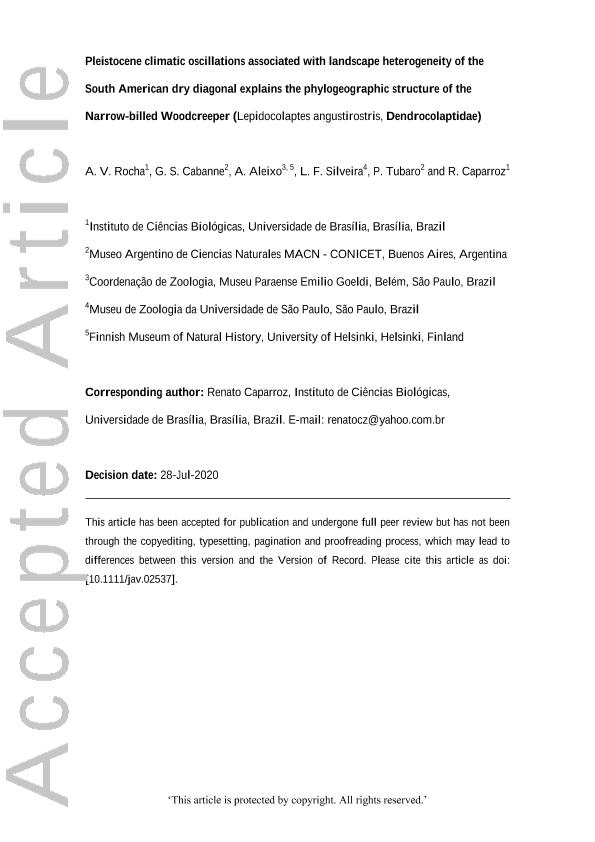Artículo
Pleistocene climatic oscillations associated with landscape heterogeneity of the South American dry diagonal explains the phylogeographic structure of the narrow-billed woodcreeper (Lepidocolaptes angustirostris, Dendrocolaptidae)
Rocha, A. V.; Cabanne, Gustavo Sebastián ; Aleixo, A.; Silveira, L. F.; Tubaro, Pablo Luis
; Aleixo, A.; Silveira, L. F.; Tubaro, Pablo Luis ; Caparroz, R.
; Caparroz, R.
 ; Aleixo, A.; Silveira, L. F.; Tubaro, Pablo Luis
; Aleixo, A.; Silveira, L. F.; Tubaro, Pablo Luis ; Caparroz, R.
; Caparroz, R.
Fecha de publicación:
08/2020
Editorial:
Wiley Blackwell Publishing, Inc
Revista:
Journal Of Avian Biology
ISSN:
0908-8857
Idioma:
Inglés
Tipo de recurso:
Artículo publicado
Clasificación temática:
Resumen
Based on phylogeographic and niche model analyses of the narrow-billed woodcreeper Lepidocolaptes angustirostris, we evaluated the predictions of two diversification hypotheses related to the dry diagonal of South America: (I) isolation by distance (IBD) and (II) landscape heterogeneity. We also investigated the influence of the Pleistocene climatic oscillations on the diversification and population dynamic of this species, and discussed the implications of our findings for the taxonomy of this woodcreeper. We sampled 63 individuals including all subspecies described for L. angustirostris, and compared them using a mitochondrial (ND2) and a nuclear (FIB5) fragments. We performed a Mantel test and spatial autocorrelation analysis, reconstructed the phylogenetic relationships among haplotypes, investigated changes in population size and estimated divergence time among the genetic lineages. We refuted the hypothesis that bird species associated with open environments have shallow geographic differentiation and showed that strong genetic structure observed in L. angustirostris can not be explained by IBD. Paleo-modeling showed strong association between climatic stable areas and the genetic lineages, suggesting that Pleistocene climatic oscillations have primarily driven the intraspecific diversification of this species. In addition, the association between genetic lineages and the dry diagonal biomes supports that landscape heterogeneity may be acting as a secondary barrier restricting gene flow among the lineages. The genetic lineages found in L. angustirostris do not correspond to the subspecies described, indicating that this species can be considered as a single species with strong genetic structure. In conclusion, our data corroborate other studies indicating that Pleistocene climatic oscillations may have had a strong influence in the intraspecific divergence of dry diagonal fauna and that biomes of the dry diagonal should be considered as independent units in further biogeographic studies.
Palabras clave:
BIOGEOGRAPHY
,
CAATINGA
,
CERRADO
,
CHACO
,
ISOLATION BY DISTANCE
,
STDFS
Archivos asociados
Licencia
Identificadores
Colecciones
Articulos(MACNBR)
Articulos de MUSEO ARG.DE CS.NAT "BERNARDINO RIVADAVIA"
Articulos de MUSEO ARG.DE CS.NAT "BERNARDINO RIVADAVIA"
Citación
Rocha, A. V.; Cabanne, Gustavo Sebastián; Aleixo, A.; Silveira, L. F.; Tubaro, Pablo Luis; et al.; Pleistocene climatic oscillations associated with landscape heterogeneity of the South American dry diagonal explains the phylogeographic structure of the narrow-billed woodcreeper (Lepidocolaptes angustirostris, Dendrocolaptidae); Wiley Blackwell Publishing, Inc; Journal Of Avian Biology; 51; 9; 8-2020; 1-38
Compartir
Altmétricas



